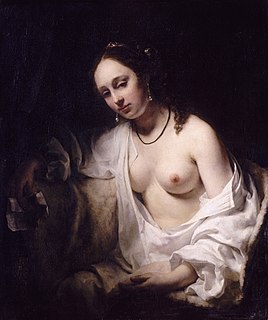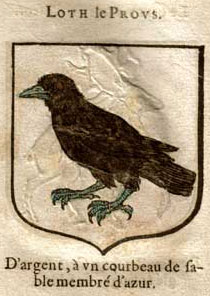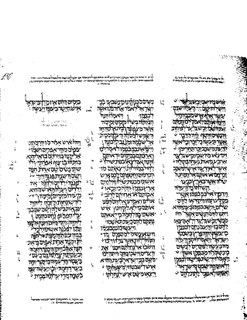
Samson was the last of the judges of the ancient Israelites mentioned in the Book of Judges and one of the last leaders who "judged" Israel before the institution of the monarchy. He is sometimes considered as an Israelite version of the popular Near Eastern folk hero also embodied by the Sumerian Enkidu and the Greek Heracles.

Bathsheba was the wife of Uriah the Hittite and later of David, according to the Hebrew Bible. She was the mother of Solomon, who succeeded David as king, making her the Gebirah. She is best known for the Biblical narrative in which she was summoned by King David, who had seen her bathing and lusted after her.

Delilah is a woman mentioned in the sixteenth chapter of the Book of Judges in the Hebrew Bible. She is loved by Samson, a Nazirite who possesses great strength and serves as the final Judge of Israel. Delilah is bribed by the lords of the Philistines to discover the source of his strength. After three failed attempts at doing so, she finally goads Samson into telling her that his vigor is derived from his hair. As he sleeps, Delilah orders a servant to cut Samson's hair, thereby enabling her to turn him over to the Philistines.

King Lot, also spelled Loth, is a British monarch in Arthurian legend. He was introduced in Geoffrey of Monmouth's influential chronicle Historia Regum Britanniae that portrayed him as King Arthur's brother-in-law and under-king, who serves as regent of Britain during the time between the reigns of Uther and Arthur. In the wake of Geoffrey, Lot has appeared regularly in the works of chivalric romance, alternating between the roles of Arthur's enemy and ally. He chiefly figures as ruler of the northern realm of Lothian and sometimes Norway; in other texts he rules Great Britain's northernmost Orkney isles. He is generally depicted as the husband of Arthur's sister or half-sister, often known as Anna or Morgause. The names and number of their children vary depending on the source, but the later romance tradition has given him the sons Gawain, Agravain, Gaheris, Gareth, and Mordred. Lot's literary character is likely connected to the hagiographical material concerning Saint Kentigern, which feature Leudonus as king of Leudonia and father of Saint Teneu.

The Seal of Solomon or Ring of Solomon is the signet ring attributed to the Israelite king Solomon in medieval mystical traditions, from which it developed in parallel within Jewish mysticism and Islamic mysticism as well as in Western occultism. It is the predecessor to the Star of David, the contemporary cultural and religious symbol of the Jewish people.

Stories from the Bible have frequently been used in films. There are sound reasons for motion picture producers to turn to the Bible as source material. The stories, in the public domain, are already familiar to potential audiences. They contain sweeping, but relatively straightforward, narratives of good versus evil, and feature crowd-pleasing battles, sword fights, natural disasters, and miracles.

Sex is considered repeatedly in the Hebrew Bible. Some references provide unambiguous ethical regulations, such as the laws given in Leviticus or Deuteronomy. Others are more ambivalent, most famously the potentially homosexual actions of Ham with his father, Noah. Its depictions of homosexuality, rape, prostitution and incest have spurred considerable academic and theological attention.

Women in the Bible are wives, mothers and daughters, victors and victims, women who change the course of historical events, and women who are powerless to affect even their own destinies.

Jewish mythology is the body of myths associated with Judaism. Elements of Jewish mythology have had a profound influence on Christian mythology and on Islamic mythology, as well as on world culture in general. Christian mythology directly inherited many of the narratives from the Jewish people, sharing in common the narratives from the Old Testament. Islamic mythology also shares many of the same stories; for instance, a creation-account spaced out over six periods, the legend of Abraham, the stories of Moses and the Israelites, and many more.

Bathsheba at Her Bath is an oil painting by the Dutch artist Rembrandt (1606–1669) finished in 1654.

There are a number of passages in the Hebrew Bible that have been interpreted as involving same-sex sexual acts, desires, and relationships. The passages about homosexual individuals and sexual relations in the Hebrew Bible are found primarily in the Torah and have been interpreted as referring primarily to male homosexual individuals and sexual practices.

Goltzius and the Pelican Company is a 2012 historical film by writer-director Peter Greenaway.

The Queen Mary Psalter is a fourteenth-century English psalter named after Mary I of England, who gained possession of it in 1553. The psalter is noted for its beauty and the lavishness of its illustration, and has been called "one of the most extensively illustrated psalters ever produced in Western Europe" and "one of the choicest treasures of the magnificent collection of illuminated MSS. in the British Museum".

2 Samuel 11 is the eleventh chapter of the Second Book of Samuel in the Old Testament of the Christian Bible or the second part of Books of Samuel in the Hebrew Bible. According to Jewish tradition the book was attributed to the prophet Samuel, with additions by the prophets Gad and Nathan, but modern scholars view it as a composition of a number of independent texts of various ages from c. 630–540 BCE. This chapter contains the account of David's reign in Jerusalem. This is within a section comprising 2 Samuel 9–20 and continued to 1 Kings 1–2 which deal with the power struggles among David's sons to succeed David's throne until 'the kingdom was established in the hand of Solomon'.

The "Power of Women" is a medieval and Renaissance artistic and literary topos, showing "heroic or wise men dominated by women", presenting "an admonitory and often humorous inversion of the male-dominated sexual hierarchy". It was defined by Susan L. Smith as "the representational practice of bringing together at least two, but usually more, well-known figures from the Bible, ancient history, or romance to exemplify a cluster of interrelated themes that include the wiles of women, the power of love, and the trials of marriage". Smith argues that the topos is not simply a "straightforward manifestation of medieval antifeminism"; rather, it is "a site of contest through which conflicting ideas about gender roles could be expressed".

The Hebrew Bible contains a number of references to rape and other forms of sexual violence, both in the Law of Moses, its historical narratives and its prophetic poetry.

The daughters of the biblical patriarch Lot appear in chapter 19 of the Book of Genesis, in two connected stories. In the first, Lot offers his daughters to a Sodomite mob; in the second, his daughters have sex with Lot without his knowledge to bear him children.

Bathsheba are names given to a c 1480 oil on wood panel painting by the Early Netherlandish artist Hans Memling, now in the Staatsgalerie, Stuttgart. Its unusually close framing and the fact that many of the details are cut off suggests that it is a fragment of a larger, probably religious, panel or triptych that was broken up. The painting is noted for being a rare 15th century depiction of a nude person in Northern Renaissance art; such figures typically only appeared in representations of the Last Judgement, and were hardly as deliberately erotic. Memling is attributed one other secular nude portrait, in the center panel of his c. 1485 Vanitas allegory Triptych of Earthly Vanity and Divine Salvation, at the Musée des Beaux-Arts, Strasbourg. As opposed to Bathsheba, that nude is fully exposed, with visible genitalia.

















